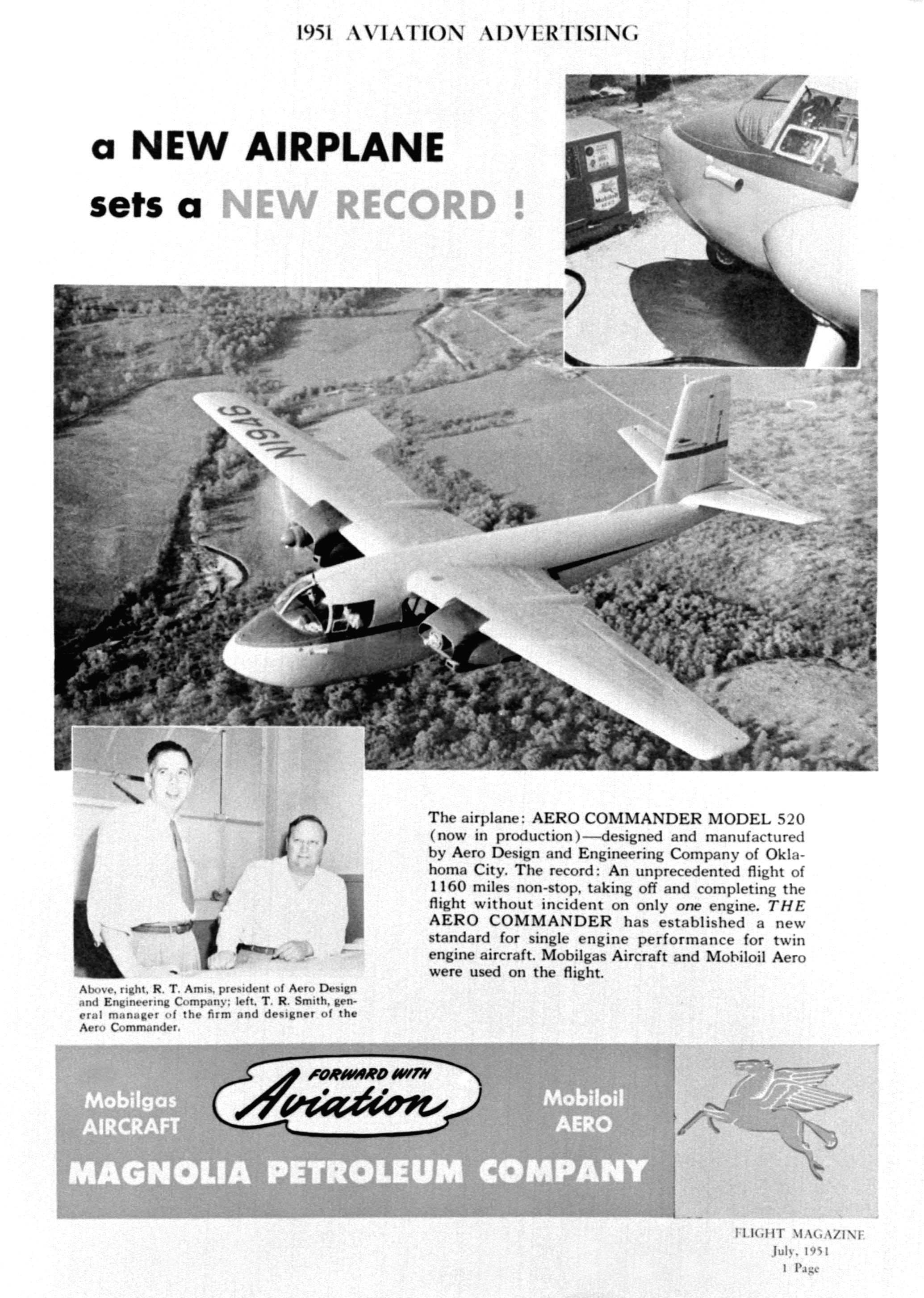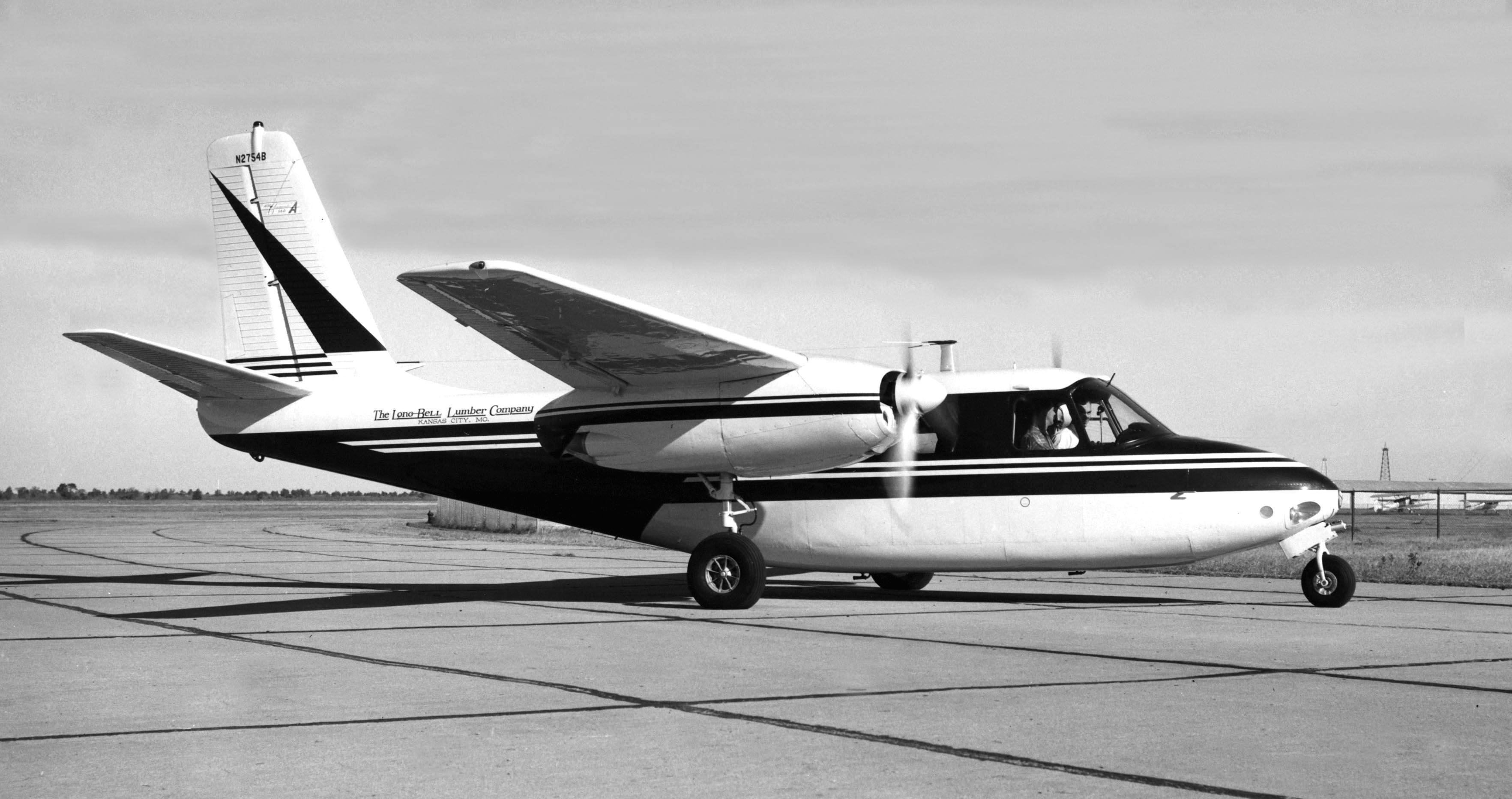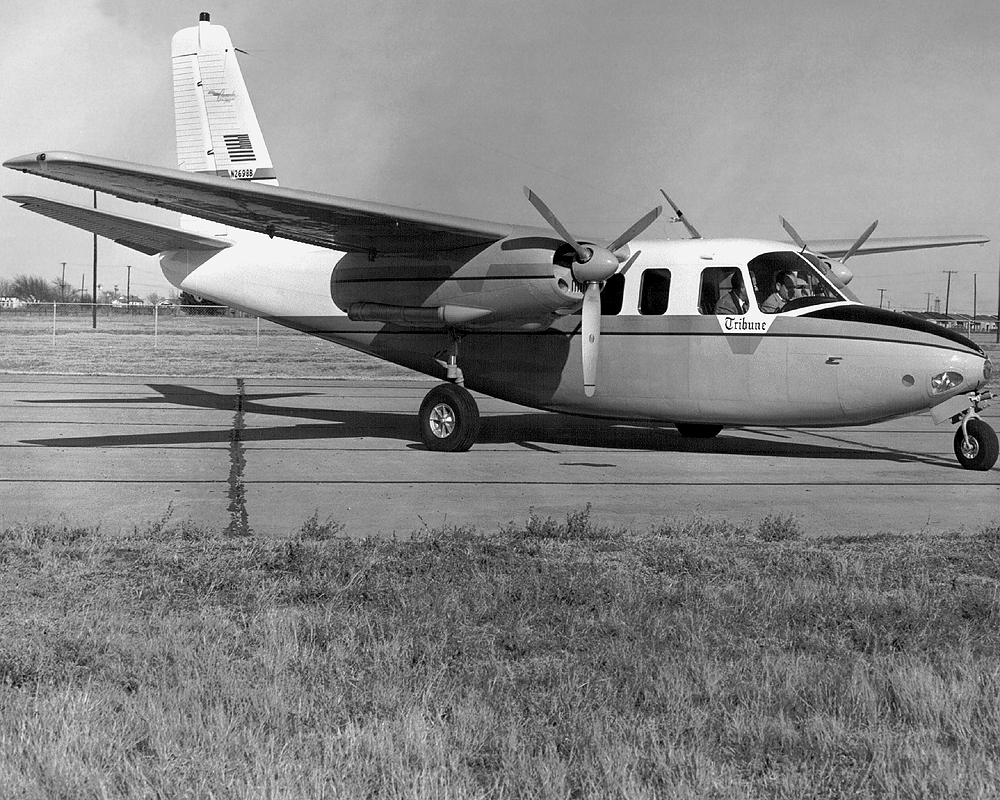Twin Commander Aircraft History
The history of the Twin Commander, first called the Aero Commander, can be traced back to a project engineer at Douglas Aircraft Company named Ted Smith who worked for Douglas during WWII. After the end of the war, commercial airlines had begun to develop a network of flights within the US, but Mr. Smith believed a significant void existed for the needs of business travelers and individuals who traveled to destinations not frequently served by commercial carriers. These business travelers and individuals also had higher demands for convenience, flexibility and time savings that could only be met through a private aircraft. They also wanted the comfort, safety and dependability of a commercial aircraft.
In response to this market void, Mr. Smith assembled a team of 14 engineers to design what would be the first Twin Commander. The preliminary configuration and design was completed in 1946 and the first prototype took its maiden flight on April 23, 1948. With the design proven through test flights, the team set out to raise capital to finance the final development and initial production of the aircraft. Three wealthy aerospace enthusiasts who had shown support for the project were George Pew, a Philadelphia engineer and pilot, and two brothers from Oklahoma City, Rufe and William Amis. These men, together and with other interested Oklahoma City individuals, provided the capital required to continue the necessary engineering and testing of the prototype, leading to its certification by the then CAA in June, 1950. After certification, George Pew and the Amis brothers contributed additional capital to finance production.
The Company was reorganized in September of 1950 as the Aero Design and Engineering Co. with George Pew as Chairman, Rufe Amis as President and Bill Amis as Vice President. The facility was located at what is now Wiley Post Airport outside Oklahoma City and consisted of an aircraft hanger and 26,000 sq. ft. manufacturing facility. The aircraft was well received by the market due to its high level of capability. At the time, there was not another plane on the market similar to the Aero Commander. The Aero Commander also had an unprecedented margin of safety relative to other aircraft due to its single engine performance capabilities. The Aero Commander was capable of taking off, flying and landing on a single engine while maintaining a high degree of stability. To prove this, and to enhance market recognition of the plane, in May of 1951, the Company successfully completed a flight from Oklahoma City to Washington DC loaded to full gross weight with one propeller removed from the plane. This was a first for the aviation industry and a strong demonstration of the asymmetric control and responsiveness of the Aero Commander.
Backlog filled rapidly after the record breaking flight. The first production Aero Commander, the piston powered model 520, rolled off the assembly line in August of 1951. In 1954, the 520 was replaced by the 560 and 560A that featured a larger cabin and more powerful Lycoming piston engines. In 1955, the US Air Force selected the Aero Commander as the personal transport for President Eisenhower due to its “exceptional performance characteristics.” The Aero Commander was the first light twin engine aircraft considered safe enough for use by the President. The US Air Force ordered fifteen Twin Commanders, two of which were placed in the service of the White House. In 1957, the Twin Commander broke the distance record for general aviation aircraft by flying a distance of 1,504.74 nautical miles from Guatemala City, Guatemala to Oklahoma City.
In 1958, the Company introduced the first pressurized business aircraft in the form of the model 720 Alti-Cruiser. This achievement led to the acquisition of the Company by Rockwell-Standard & Associates in the same year. As a wholly owned subsidiary of Rockwell, the Company had access to capital for additional development and production expansion. The aircraft adopted fuel injection engines and underwent several modifications to reduce drag and increase performance. The resulting aircraft, introduced in 1960, is known as the Twin Commander. While other modifications were made over time to many parts and systems of the Twin Commander, the majority of the final design released in 1960 continued through the end of production of the Twin Commander in 1984.
The advent of the small gas turbine engine lead to market demand for increased speed. In response to this demand, the 680 T model was released in 1964 and later the 690 series in 1971 followed by the JetProp series in 1979. The 690 series represented another significant advancement in the planes’ overall speed, using AiResearch TPE331 turbine engines. It also featured other modifications for increased flight safety, fuel efficiency and flight stability such as increased wing length and rudder area; increased maximum altitude; standard de-ice equipment; increased weight capacities; better cabin pressurization; and a heated windshield.
In February 1981, Rockwell International, the successor company to Rockwell-Standard, was acquired by Gulfstream Aerospace. In the early 1980’s the final and most advanced model of the Twin Commander was released. The model 1000 was powered by Dash 10 engines. This model represented the high point of design and innovation of the Twin Commander and remains one of the primary turboprop benchmarks of the general aviation industry. The model 1000 featured increased speed, range and climbing ability over previous Twin Commander models with similar fuel efficiency.
In December of 1985, Gulfstream Aerospace was acquired by Chrysler Corp. Senior management at the acquiring company chose to focus the resources of Gulfstream on the business jet market and production of the Twin Commander ceased in 1986. Gulfstream continued to support the fleet until 1989 when the Twin Commander Aircraft subsidiary of Gulfstream was acquired by Precision Aerospace Corporation (“Precision”). In acquiring the company, Precision also acquired all of the type and production certificates, rights, tooling and drawings for all Twin Commander models ever produced. Precision completed the transition of the Company from an OEM aircraft manufacturer to an industry leading OEM parts, service and support provider. The Company was reincorporated as Twin Commander Aircraft LLC in 2003, and then acquired by James and Mark Matheson from Precision in a 2005 management buyout. In August of 2008, the Matheson’s sold the company to Firstmark Corp. of Richmond, Va., a company with a long history of supporting legacy aircraft. To this day, Firstmark Corp. continues to operate Twin Commander Aircraft LLC as an industry-leading OEM parts and service provider and in cooperation with a worldwide factory-authorized Service Center network, maintains the Commander fleet as one of the most efficient, versatile, and capable airframes ever built.
TWIN COMMANDER MODEL OVERVIEW
The Twin Commander is known for its segment leading fuel efficiency, large cabin and long range capabilities. Since the plane’s original production that began in the 1950s, there have been numerous model variants. Over time, the Twin Commander evolved through each iteration with performance and capability enhancements, added features, design upgrades and new power plants. Twin Commander models can be divided into three categories by power plant type: Early piston engine powered models; turbine powered models; and the most recent JetProp models. The following is a breakdown of the major Twin Commander model designations.
PISTON ENGINE MODELS
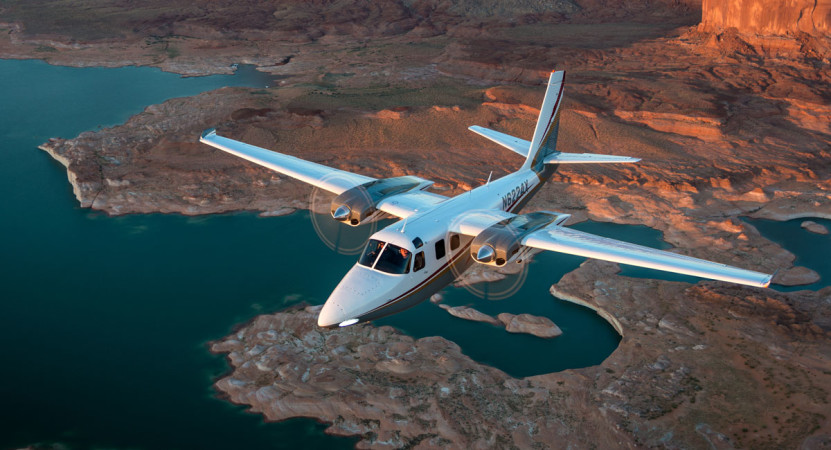
The first models of the Twin Commander were originally called Aero Commander and built in the early 1950s. These aircraft were powered by twin Lycoming piston engines rated at 290hp and have 500 series model designations. Over 1,000 of these planes are still flying today. Apart from the engines, the primary difference between these early planes and the more modern Turbine and JetProp powered models was the length of the plane. Early 500 series models were approximately 36 feet long whereas later models were 42 to 44 feet long.
Model 500S / 520
The model 500S, also known as the model 520, is the original Twin Commander. The prototype design was certified by the CAA, the predecessor organization to the FAA, in 1950. The first 500S rolled off the assembly line in August of 1951. The 500S was known as the Shrike Commander. Despite its shorter length compared to later models, the 500S could comfortably carry seven passengers and 350 lbs. of luggage. The plane had a maximum range of 693 nautical miles that was considered long for light aircraft of the time period. The unpressurized cabin and piston engines limited the 500S to a 15,000 ft. ceiling. A prototype of the 500S is the model that completed the historic single engine flight from Oklahoma City to Washington D.C. in May of 1951.
Model 560 / 560A
The 560 and 560A models replaced the 500S and 520 models in 1954. The success of the 500S and 520 models allowed engineers at the Aero Design & Engineering Co. to design a larger cabin into the 560A model by adding 10 inches to the overall length of the fuselage. In addition, the 560 series featured improved and more powerful Lycoming piston engines that led to significant performance improvements over the 500S and 520. The 560 series marked a significant milestone for the Twin Commander as well as the general aviation industry. The 560 model was the first light twin engine aircraft considered safe enough by the US Air Force for use by the President. Later variants of the 560 featured more powerful engines, 32 inch winch tip extension, hydraulics modifications, redesigned landing gear, fuel injection engines and minor fuselage changes.
Model 680FL, 680V
The 680FL was introduced in May of 1963 as the “Grand Commander”. This was the first Twin Commander model featuring the lengthened fuselage seen on later Turbine and JetProp powered models. Two sections were added to the plane, a 44 inch section forward of the front spar and a 30 inch section aft of the front spar. This added over six feet to the length of the plane, bringing overall length to over 42 feet. The Twin Commander offered leading cabin area space per occupant and the plane’s gross weight rating increased to 8,500 lbs. The 680V introduced the large under wing picture windows that offered rear cabin occupants an unprecedented outward view from the plane. These windows would become a Twin Commander trademark in future years.
TURBINE MODELS
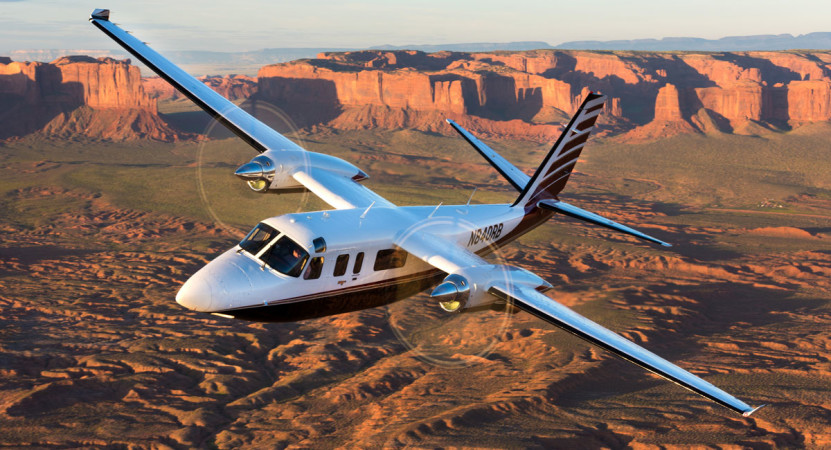
The growing use of jet engines throughout the 1960s by commercial airlines led to demand by the general aviation market for increased aircraft speed. This market demand increased in the late 1960s with the introduction of small jet engines for use in jet powered business aircraft. In response to this demand for increased speed, the Company undertook design and certification work for the first turbine powered Twin Commanders during 1964 and 1965. The first turbine powered Twin Commander was the 680T called the “Turbo Commander” that used Garrett AiResearch TPE331 turbine engines. The increased power of the Garrett AiResearch engines allowed for a gross weight rating of just under 9,000 lbs., better flight performance characteristics and increased take off power. The high gross weight rating and additional power required certain configuration changes to the airframe that altered the flight characteristics of the plane. The 690A and 690B models that followed the 680T were the primary turboprop Twin Commander models.
Model 690A
The 690A, first produced in 1973, represented a significant advancement for turboprop Twin Commander aircraft. This model used the more powerful 251K variant of the AiResearch TPE331 power plant and Hartzell propellers. Airframe changes included an increase of 30 inches at the center wing section, increased rudder area, enlarged dorsal fin and longer tail cone. These changes allowed for a gross weight rating of 9,600 and baggage capacity of 600 lbs., the highest for a Twin Commander. Other changes such as the addition of a heated windshield, increased cabin pressure differential and standard de-icing equipment, changed the maximum ceiling rating from 25,000 feet to 31,000 feet.
Model 690B
The 690B first flew in 1976 and was similar to the 690A with increased weight ratings, two engine options and several modifications to the cabin interior including larger baggage space.
JETPROP MODELS
In the late 1970s and early 1980s, the Company released several enhanced turbine powered models called “JetProp.” These aircraft represent the most advanced Twin Commanders ever produced. Of the JetProp Twin Commanders, the model 1000 is the most powerful and advanced aircraft.
Model 840
Major changes were made to the Twin Commander with the introduction of the model 840 in 1979. The wings were increased 30 inches and canted winglets were added to increase total wing area. The 254K variant of the AiResearch gas turbine TPE331 engines were used that generated 717.5 shaft horsepower each with new Dowty full feathering and reversible propellers. Wet wings were added outboard of the nacelles increasing fuel capacity from 384 to 482 gallons. The increased fuel capacity of the wet wings and fuel efficiency of the new engines allowed the 840 to have a maximum range of 2,040 nautical miles. It was the first Twin Commander to break the 2,000 nautical mile range barrier. Aircraft dry weight decreased by 507 lbs. over the 690B.
Model 980
The model 980 was the same as the 840 except for the more powerful Honeywell TPE331-511k engines with 733 shaft horsepower. These engines decreased the time to climb to an altitude of 20,000 feet from 9.5 minutes on the 840 to 7.2 minutes on the 980.
Model 900
The model 900, released in 1981, featured continued advancement of the engines and capabilities of the plane. Shaft horsepower increased to 748.3 per engine while landing weight increased almost 1,000 lbs. over previous models to 10,550 lbs. The most important advancement of the model 900 was the interior layout. Without extending the overall length of the fuselage, the cabin interior was lengthened by three feet increasing total cabin volume to 278 square feet. This change gave the model 900 one of the best cabin volume per passenger ratings in its segment. The model 900 and model 1000 (below) were the only two models designed and released under Gulfstream ownership.
Model 1000
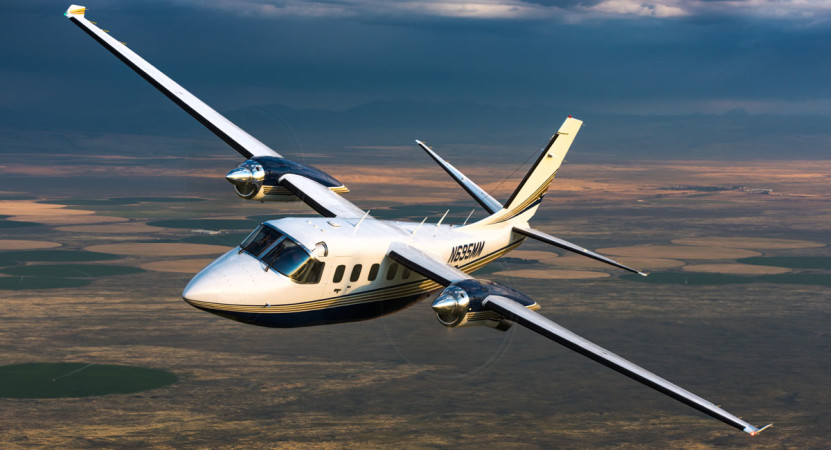
The model 1000 is the most advanced version of the Twin Commander. The first version of the 1000 (695A) was certified in April, 1981 and was the same aircraft as the model 900 except that it used Honeywell TPE331-511k engines, better known as Dash 10. In February, 1984 a second version of the model 1000 was released (695B) that used Dash 10 engines, raising shaft horsepower output to 820 per engine. This gave the aircraft a maximum cruising speed of 308 knots and maximum range of 2,080 nautical miles on 482 gallons of fuel. The maximum ceiling rating increased to 35,000 feet. Weight ratings also increased slightly over the model 900. Minor structural changes were made to the 1000 to accommodate the increased weight ratings and engine power. Please see the following section “JetProp Commander vs. Competing Aircraft” for further information about the model 1000.
